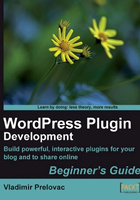
Chapter 2. Social Bookmarking
I hope the first chapter got you warmed up and prepared for WordPress plugin development, and that you are as eager to start as I am.
In this chapter, we will create our first functional WordPress plugin and learn how to interact with the WordPress API (this is the WordPress interface to PHP) on the way. The knowledge you will gain in this chapter alone will allow you to write a lot of similar plugins.
Let's get moving! In this chapter, you will learn:
- Creating a new plugin and having it displayed in the plugins admin panel
- Checking the WordPress version and control activation of the plugin
- Accessing API features—for example the title and permalink URL of each post
- Using WordPress hooks to execute your plugin code when it's needed
- Using conditional tags to control the flow of your plugins
You will learn these by:
- Creating a 'social bookmarking' type of plugin that adds a Digg button to each post on your blog

As you probably know, Digg is a very popular service for promoting interesting content on the Internet. The purpose of a Digg button on your blog is to make it easier for Digg users to vote for your article and also to bring in more visitors to your blog.
The plugin we'll create in this chapter will automatically insert the necessary code to each of your posts. So let's get started with WordPress plugin development!